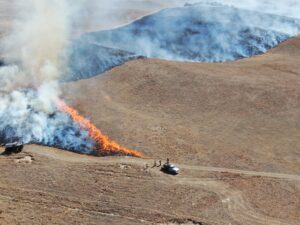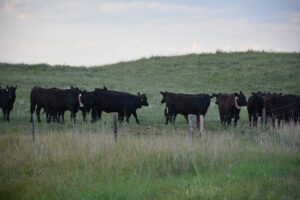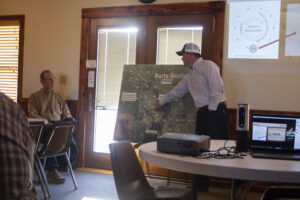Project Overview
Information Products
Commodities
- Agronomic: grass (misc. perennial)
- Additional Plants: native plants
- Animals: bovine
Practices
- Animal Production: grazing management, range improvement, rangeland/pasture management
- Education and Training: demonstration, extension, on-farm/ranch research, participatory research
- Farm Business Management: budgets/cost and returns
- Natural Resources/Environment: biodiversity, indicators, soil stabilization, wildlife
- Sustainable Communities: social psychological indicators
Abstract:
Problem Addressed and Solution Pursued
The Nebraska Sandhills region is one of the largest (20,179 miles2), intact native temperature grasslands remaining in the world. Sandhills grasslands are used primarily for beef cattle production, but these ecosystems also provide important wildlife and plant species habitat, wetlands and water infiltration for recharge of the Great Plains aquifer, and other ecosystem services such as recreation. Vegetation management typically includes a combination of grazing strategies, mechanical and chemical control of invasive plants, and, less frequently, prescribed fire. Tradeoffs that occur among competing ecosystem services (e.g., soil health, cattle weight gain, economic return, wildlife diversity) and disservices (e.g., invasive species, low plant diversity, compromised soils) must be evaluated and quantified when making management decisions that have consequences for sustaining livelihoods.
[caption id="attachment_971813" align="alignleft" width="373"] Prescribed burn at Barta Brothers Ranch. Courtesy: TL Meyer, Beef Educator, Nebraska Extension.[/caption]
Prescribed burn at Barta Brothers Ranch. Courtesy: TL Meyer, Beef Educator, Nebraska Extension.[/caption]
The collaborative adaptive management (CAM) project at Barta Brothers Ranch evaluates alternative, stakeholder-designed approaches to grassland management in the Sandhills and surrounding north-central Great Plains. CAM is often described simply as learning by doing or learning through management, which is true. However, CAM is more than simple trial-and-error; it involves strategically targeting uncertainties through experimentation and learning and then adjusting management accordingly. Simply put, CAM is about managing together, learning together, and putting that learning into practice over time.
At the outset, it is critical to define the problem being addressed and objectives of the CAM process. Initial meetings with the CAM Project Team (ranchers, land managers, researchers) broadly identified management of invasive species, enhancing livestock performance, and managing for heterogeneity and multifunctionality, or multiple ecosystem services on the same land area, as key problems/uncertainties and primary objectives for the research. Testing of management approaches for halting or reversing encroachment of eastern redcedar in the context of livestock production was identified as a particular uncertainty. A patch-burn grazing system was recommended as a management practice that could address these areas of concern. A patch-burn grazing system was implemented alongside a deferred rotational grazing system (status quo) over four grazing seasons (2022 - 2025) and ecological, animal, and economic outcomes were monitored and compared over time. Participants met at least semi-annually for field tours, to discuss monitoring outcomes in relation to key uncertainties, and to make any needed management approach adjustments.
Research Approach, Educational Approach, and Learning Outcomes
Utilizing the adaptive management framework, researchers established protocols to monitor and compare outcomes in woody vegetation, herbaceous vegetation, livestock, soil, and social learning among stakeholders before, during, and after a set of four grazing seasons in a patch-burn grazing system and a deferred rotational grazing system. In the springs of 2022, 2023, and 2024, through cooperation among stakeholders in the region, Barta Brothers Ranch completed prescribed burns in a series of 160-acre pastures within a four-pasture system. By opening gates between pastures, cattle were allowed to openly graze all four pastures in the patch-burn system (i.e., season-long continuous grazing), while cattle in the deferred rotational grazing system were rotated among each of the four pastures in each grazing season. In 2025, it was infeasible to implement prescribed fire due to dry and windy conditions and a burn ban; therefore an early stocking option was implemented in the pasture instead of burning, followed by continuous grazing in all four pastures, with gates between pastures open.
[caption id="attachment_971874" align="alignright" width="350"] Cattle wearing GPS collars in the field. Courtesy: Dr. Mitch Stephenson, University of Nebraska.[/caption]
Cattle wearing GPS collars in the field. Courtesy: Dr. Mitch Stephenson, University of Nebraska.[/caption]
Each year, animals (spayed heifers) were put out to pasture in mid-May and removed in mid-September. Stocking rates (.62 AUMs/acre) reflected real-world conditions and were held constant throughout the grazing seasons despite variable conditions, including periods of above-average precipitation and regional drought. As a control, a similarly stocked four-pasture deferred rotational system was also established at Barta Brothers Ranch. Within each pasture, animals were weighed three times during the grazing season with the movements of some heifers (n=8) tracked via GPS collars and their diets monitored via fecal DNA, microhistology, and field surveys. Ecological variables compared between the patch-burn grazing and deferred rotational grazing system included plant community composition and structure, eastern redcedar mortality, bird community composition, soil nutrient levels, and soil erosion rates.
Learning outcomes for participants in the CAM process involve articulation of four forms of knowledge: CAM-reinforced, CAM-amended, CAM-generated, and CAM-attainable. Semi-annual on-ranch meetings, along with Zoom/phone and email communication, took place each year. This active engagement among stakeholders is foundational to the CAM approach. Through the co-production of science, shared learning and trust are fostered among the participants in the CAM research project at Barta Brothers Ranch. An online survey and two group mental modeling activities--one in early 2022 and one in late 2025--captured participant perceptions of the alternative rangeland management approaches. At the conclusion of the 2021 - 2025 CAM iteration, participants articulated: 1) things they knew prior to CAM, and still know (CAM-reinforced knowledge); 2) things they thought they knew prior to CAM, but have amended (CAM-amended knowledge); 3) things they didn't know prior to CAM, and learned through it (CAM-generated knowledge); and 4) things they still want to know (CAM-attainable knowledge).
Key Research Conclusions
- Cattle in the patch-burn system had better performance than cattle in the deferred rotational grazing system in each of the four studies years, with 22-31% greater average daily gains.
- Cattle in the patch-burn system brought better economic returns in each of the four years, with an average of $86-$138 more per head at the sale barn.
- Cattle selected recently burned patches over unburned patches early in the grazing season and that as the grazing season progressed, cattle increasingly selected the unburned pastures, until there was no effect of burning on cattle selection by August of each year.
- Within burned pastures, cattle were more likely to use open slopes and uplands than in unburned pastures.
- In 2024, we found 72% overall eastern redcedar mortality across 1,160 trees in a pasture within the patch-burn grazing system, with greater counts and mortality rates of smaller trees.
- In 2022–2024, we found that by August of each year, there were no effects of prescribed fire on vegetation productivity.
- We found no substantial differences in erosion between burned and unburned pastures, with both experiencing relatively small amounts of erosion/deposition (1 – 3 centimeters) and neither demonstrating an effect across entire pastures in the year of treatment or subsequent years.
- Canopeo-derived proportion of green pixel estimates provide reasonable estimates of total aboveground biomass in Sandhills ecosystems when sampling in the months of June and August.
- Following removal (mulching) of established eastern redcedar stands, initial results indicate high variability in species composition among the mulched plots and high proportions of annual plant species, compared to reference grassland sites.
Stakeholder Adoption Actions
Stakeholders articulated four forms of knowledge useful for informing management decisions moving forward--highlights of which from the November 2025 on-ranch meeting are presented below.
CAM-Reinforced Knowledge Highlights
- Prescribed fire is effective at controlling and reducing eastern redcedar encroachment in Sandhills ecosystems.
- Cattle were attracted to recently burned grassland patches.
- Prescribed fire increased forage nutritional quality.
- Patch-burn grazing increases grassland heterogeneity.
- Sandhills ecosystems were resilient to the linked prescribed fire and grazing disturbance.
- Patch-burn grazing is a workable and effective management system in the Nebraska Sandhills.
CAM-Amended Knowledge Highlights
- Forage production was more stable after fire and grazing than anticipated.
- Warm-season grasses remained more productive under patch-burn grazing then expected.
- Plant diversity and total production varied more than expected following prescribed fire.
- Vegetation in burned and grazed pastures recovered more quickly then expected.
- Cattle attraction to burned patches lasted longer then expected.
- Cattle average daily weight gains in the patch-burn system exceeded expectations.
- Grazing immediately after prescribed fire is more feasible and less risky than initially perceived.
- Eastern redcedar seedlings and resprouts appeared more quickly post-fire than expected.
CAM-Contributed Knowledge Highlights
- The strength of the fire-grazing interaction is stronger than previously documented in Sandhills landscapes.
- The combined effect of fire, grazing, and drought requires roughly two years of recovery under adequate precipitation.
- Cattle utilization of little bluestem was greater than assumed.
- Yearling cattle displayed strong gains in the patch-burn system under drought.
- Cattle effectively locate open gates and move effectively among pastures in the patch-burn system.
- Cattle responses to shifting forage availability was clear and quantifiable.
- Mulching large cedar stands has important ecological and operational tradeoffs.
- There was no substantial erosion in early-burned pastures.
CAM-Attainable Knowledge Highlights (continuing questions)
- Is prescribed fire cost effective and ecologically beneficial in areas without current woody plant encroachment?
- What is the optimal fire return interval for Nebraska Sandhills ecosystems under average conditions?
- What is the best alternative timing for fire if spring weather conditions prevent burning?
- How does grazing deferment length before burning (full, partial, or seasonal rest) affect eastern redcedar mortality?
- Can burning only slopes or certain topographic positions improve cost-effectiveness?
- When should cattle be turned out into grazed areas and how much ungrazed area should remain within a patch-burn grazing system?
- What are the effects of grazing burned patches during the cattle breeding season, particularly on cow breed-back?
- How do different livestock classes (cows, yearlings, small ruminants) respond to fire-altered forage?
- Do high-density grazing systems offer consistent benefits following fire?
- What are the effects of weather variability on plant biomass and functional group cover responses in a patch-burn grazing system?
- How does the timing of fire influence C3 versus C4 species composition over time?
- What are the responses of less-studied species (e.g., leadplant, roses, yucca, poison ivy) under patch-burn grazing?
- What are warm-season grass recovery rates under patch-burn grazing?
- Over the long term, how do forage production and animal performance compare between fire/rest and patch-burn grazing systems?
- What are soil health, carbon, and organic matter responses under repeated fire-grazing cycles?
- What is the applicability of patch-burn grazing further west in the Sandhills, where it is drier and dunes are larger/steeper?
- What are the economic implications of adopting long-term (10-year) prescribed fire plans?
- What are the economic outcomes of incorporating small ruminants into cattle-dominated systems?
- Is post-fire grazing deferment worth the lost grazing days?
- What is the feasibility of dual-use systems (haying and grazing) in burned pastures?
- What are opportunities to gain fire-driven cattle performance benefits without adopting full patch-burn grazing?
- What are the long-term ecosystem service outcomes under fire-grazing systems?
Project objectives:

CAM requires stakeholder involvement from inception to completion. In this project, we: 1) Established a CAM program in the Sandhills to identify management challenges and goals; 2) Established Barta Brothers Ranch (BBR), a university-owned ranch, as a location for learning-by-management experiments, where stakeholders voice and test management hypotheses in an environment that does not affect their livelihoods; 3) Compared alternative, stakeholder-identified management approaches and evaluated their effects; 4) Monitored four forms of CAM-related stakeholder knowledge; and 5) Evaluated progress, success and uptake of CAM for rangelands.